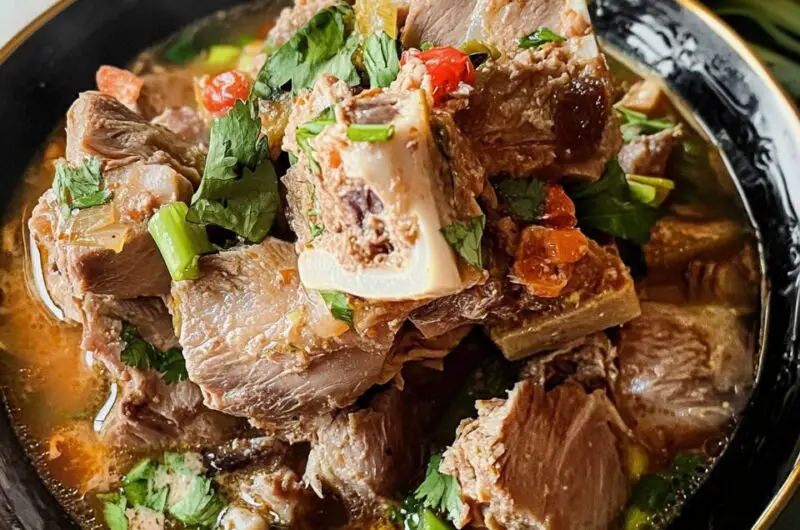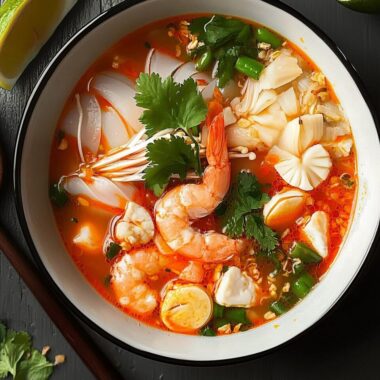This Spicy Pork Bone Soup, or Leng Saeb, is a Thai street food legend that packs a fiery punch and an herbal aroma that fills your kitchen like a Bangkok food stall. With a clear, savory broth brimming with crushed chilies, citrusy lime, and the earthy tones of lemongrass and galangal, every spoonful wakes up your taste buds. The beauty of this dish is in its simplicity and power tender pork neck bones slow-cooked to perfection, delivering meat that nearly falls off the bone, floating in a spicy herbal soup that warms you from the inside out. It’s perfect for cold days, long nights, or whenever your soul needs a culinary pick-me-up straight from Thailand.
Full Recipe:
Ingredients:
-
2 lbs pork neck bones (or pork spine)
-
8 cups water
-
1 tablespoon salt
-
1 tablespoon fish sauce (or to taste)
-
1 tablespoon lime juice
-
10-15 Thai bird’s eye chilies, smashed
-
5-6 cloves garlic, crushed
-
1 teaspoon sugar
-
4 stalks lemongrass, chopped and smashed
-
5 kaffir lime leaves, torn
-
1-inch piece galangal, sliced
-
1 medium white onion, sliced
-
1 cup oyster mushrooms
-
1 small bunch fresh cilantro, chopped
-
1 small bunch green onions, chopped
Directions:
-
Rinse pork bones under cold water. In a large pot, add water and bring to a boil. Add pork bones and boil for 5–10 minutes. Discard water, rinse bones, and clean the pot.
-
Add fresh 8 cups of water to the pot, bring to a simmer and add pork bones. Simmer gently for 1.5–2 hours, skimming off any scum.
-
Add lemongrass, galangal, kaffir lime leaves, garlic, and onions. Let simmer for 15 more minutes.
-
Add oyster mushrooms and cook until tender (about 5 minutes).
-
Season with salt, fish sauce, lime juice, and sugar. Adjust to taste.
-
Turn off heat and stir in crushed Thai chilies, chopped green onions, and cilantro just before serving.
-
Serve hot with steamed jasmine rice and lime wedges on the side.
Prep Time: 15 minutes | Cooking Time: 2 hours | Total Time: 2 hours 15 minutes
Kcal: 350 kcal | Servings: 4 servings
Exploring the Bold Flavors of Leng Saeb: Thailand’s Fiery Pork Bone Soup
Thailand is renowned for its vibrant cuisine bold, balanced, and bursting with flavor. While many people are familiar with iconic Thai dishes like Tom Yum, Pad Thai, or Green Curry, one lesser-known but equally exciting gem is Leng Saeb (เล้งแซ่บ). Known for its fiery kick and deeply aromatic broth, Leng Saeb is a dish that reflects the Thai love for spice, herbs, and slow-cooked comfort food.
In this article, we dive into the background, flavor profile, cultural significance, variations, and serving tips for this incredibly flavorful Thai soup.
What is Leng Saeb?
Leng Saeb is a spicy pork bone soup originating from the streets of Thailand. The word “Leng” refers to pork spine or neck bones, which are meaty and gelatin-rich, while “Saeb” is an Isan (Northeastern Thai) slang word meaning “delicious” or “tasty.” Together, the name embodies the essence of this dish: a delicious, savory broth loaded with tender pork and an intense mix of chili and herbs.
This dish is typically served in large bowls or even on a metal tray, with the pork bones towering above the surface of the soup. The bone marrow, fat, and cartilage slowly melt into the broth during cooking, creating a full-bodied flavor that’s unmatched by standard pork soups.
A Soup That Packs a Punch
The first thing you’ll notice when trying Leng Saeb is the spiciness. Unlike other Thai soups that balance heat with sweetness or creaminess, Leng Saeb goes all-in on fiery heat, balanced mainly with sour lime juice, salty fish sauce, and fragrant herbs like lemongrass, galangal, and kaffir lime leaves. The dish often contains dozens of bird’s eye chilies, crushed rather than sliced, releasing their full heat into the broth.
Yet, for all its intensity, Leng Saeb is well-rounded. The sour notes from lime juice and kaffir lime leaves give it a refreshing edge, while the meatiness of the bones grounds the dish. It’s not just a soup it’s an experience.
Regional Roots and Cultural Context
Leng Saeb, though popular across Thailand today, finds its strongest cultural roots in Isan cuisine. Isan, the northeastern region of Thailand, is known for dishes that favor chili heat, fermented fish sauces, and grilled meats. Leng Saeb fits right into this regional profile with its powerful flavor and rustic presentation.
It’s a staple in roadside eateries, open-air night markets, and even upscale Thai restaurants today. In Bangkok, it has become something of a trend dish, often served with dramatic presentations featuring towering stacks of bones dripping with broth and garnished with green onions and chilies.
Its popularity has also spread beyond Thailand, with Thai communities around the world embracing the dish and adapting it for local ingredients and spice tolerances.
Health Benefits and Nutritional Insights
While Leng Saeb is indulgent in flavor, it also offers surprising nutritional benefits especially if you’re making it at home and controlling the sodium levels.
Here are a few health-related benefits:
-
Rich in collagen and gelatin from the slow-cooked pork bones, which can support joint and skin health.
-
High in protein, particularly from the bone marrow and meat clinging to the bones.
-
Herbal components like lemongrass and galangal are known in traditional medicine for their digestive and anti-inflammatory properties.
-
No added sugar or dairy, making it suitable for low-carb, paleo, or dairy-free diets.
However, because of the fish sauce and salt, those watching their sodium intake may want to moderate portions or adjust seasoning to taste.
How to Serve Leng Saeb
Serving Leng Saeb is part of the fun. Here’s how you can present it for maximum authenticity and enjoyment:
-
Traditionally: Serve in a large bowl or metal tray with a heap of pork bones, allowing diners to dig in communally.
-
With sides: Pair with steamed jasmine rice or sticky rice, fresh herbs, and lime wedges.
-
Condiments: Offer extra crushed chilies, chili vinegar, or sliced raw garlic for those who want to amp up the heat.
-
For fusion flair: Add noodles or vegetables like napa cabbage or bean sprouts to make it a more substantial meal.
It’s also a great dish to pair with a refreshing Thai iced tea or a cold lager to help cool the fire.
Popular Variations of Leng Saeb
While the core ingredients remain fairly consistent, Leng Saeb can be customized based on personal taste and available ingredients:
1. Leng Saeb Nam Sai (Clear Soup Version)
This is the most common version, made with a clear broth that emphasizes the sharpness of the herbs and chilies.
2. Leng Saeb with Noodles
Some modern Thai restaurants serve the soup with rice noodles, turning it into a hybrid dish that’s perfect for lunch.
3. Seafood Leng Saeb
Less traditional, but increasingly popular in coastal areas this version replaces pork bones with crab, shrimp, or squid for a unique twist.
4. Leng Saeb Tray (Tower Presentation)
Perfect for sharing, this version is served on a wide tray with bones stacked in a pyramid shape, often decorated with chili and cilantro. It’s highly photogenic and great for social gatherings.
Cooking Tips for the Best Leng Saeb
If you’re making Leng Saeb at home, here are a few expert tips to make sure your soup is as flavorful and authentic as possible:
-
Blanch your pork bones first to remove impurities. This helps create a cleaner, clearer broth.
-
Simmer, don’t boil. A low, slow simmer is key to extracting flavor without emulsifying fat into the broth, which would make it cloudy.
-
Use fresh herbs whenever possible. Dried lemongrass or galangal won’t give the same punch.
-
Add chilies at the end. This preserves their heat and sharpness, rather than mellowing them out too much during cooking.
-
Let the soup rest for 10-15 minutes before serving it allows the flavors to meld beautifully.
Why Leng Saeb Deserves a Spot in Your Cooking Repertoire
In a world full of noodle soups, rich curries, and coconut-heavy broths, Leng Saeb stands out for its raw, unfiltered intensity. It’s not a soup that compromises; it embraces bold flavors, pungent herbs, and searing heat with unapologetic pride.
Whether you’re a Thai food aficionado or just love exploring new flavors, this dish offers an immersive culinary journey. It challenges your palate, warms your body, and feeds your soul.
Conclusion:
Leng Saeb is much more than just a pork soup it’s a dish that tells the story of Thailand’s culinary bravery. From the streets of Isan to urban food courts in Bangkok and beyond, this fiery bowl has become a symbol of Thai food’s ability to combine complexity and comfort.
With a few basic ingredients and some patience, you can recreate this dramatic and satisfying dish in your own kitchen. Serve it to friends, family, or adventurous foodies, and watch them marvel at the heat, the herbs, and the harmony of flavors.








